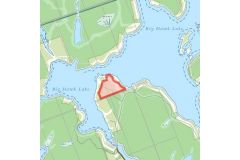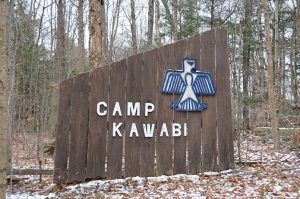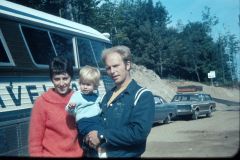Camp Kawabi
Geographic location: South shore of Big Hawk Lake
Current address: 1863 Big Hawk Lake Road, Algonquin Highlands
Date range: 1948 - 2005
Public access: No - private residence

Memories of Camp Kawabi by former campers
1948-1955: the YMCA of New York State

Camp Kawabi began as a YMCA camp out operated of Niagara Falls, New York. The camp was for “older boys” aged 13 and up and was referred to as a camp “in the Canadian Northwoods’. The landed was deeded from Wallace Scott on Dec 4, 1950.
1955-1965: Ron Perry

Ronald H. Perry was a lifelong enthusiast of camping, canoeing and the outdoors, an RCAF squadron leader in World War II, and host of a cross-country travel show on CBC radio. He was a teacher for many years, eventually becoming Headmaster at prestigious private schools. He wrote two books on canoeing and set national canoe-ing standards that are still in use today.
He bought Camp Kawabi in 1955 and hired local folks who became lifelong friends that helped set the stage for the long legacy of Camp Kawabi. Perry’s wife and children were also part of camp life for time he owned it.
Canoeing and swimming were required activities, thus setting the stage for Kawabi’s tremendous waterfront reputation. There was also archery, sailing, crafts and music. Kawabi was initially an all-boys camp with less than 100 campers; and girls were allowed to attend after parents pleaded with Perry to make the change.
Some of Hawk Lake’s established families who worked at, or attended Camp Kawabi swear that their experience at camp changed their lives (read more about the Ron Perry years here:)
The philosophy of Perry’s camp caught the attention of a young North York teacher, also a Red Cross Swim Ex-aminer who stopped in at Kawabi to test campers’ swimming skills as part of his route. That man was Bruce Harris.
1966 - 2005: Bruce and Doreen Harris

Bruce (Skip) and Doreen Harris (Nish) purchased Camp Kawabi in 1966 at only 24 and 25 years of age. This made Bruce Harris the youngest camp owner and director of an accredited camp in Ontario!
Skip & Nish believed in what Ron Perry had created and they used that foundation to continually build the Kawabi legacy, particularly around canoeing. They added 40 canoes to the waterfront program, and later introduced a wide range of water-based activities such as kayaking, discing, and waterskiing.
Other activities included fencing, archery, riflery, and crafts; and there were free periods where kids chose from tetherball, trampoline, building sand castles or snorkelling. While the activities themselves were fairly standard summer camp fare, what made Kawabi unique was the way they were organized.
Skip strongly believed that campers thrived in a family-type environment, so there was no separation of ages; no activities just for boys or girls. Every morning, each camper would use their name tags to sign up for 3 activities of their own choosing along with a scheduled swim lesson, which was mandatory.
This meant children of all ages participated in activities together, and got to know everyone. Like a very large family, the older campers would help the younger ones, and the younger ones learned from both staff members and their older peers.
The blending of ages continued into the evening activity and wide open games. Whether it was a Circus Night or Capture the Flag, or Kawabi’s very own Bucket and Squares game, everything was mixed ages and genders.
The camp’s family-style philosophy was the root of its 40 year success under the steady hand of Skip and Nish. They raised their own family there, and all three of their children were campers and then counsellors.
Skip and Nish adapted to changing times and yet managed to keep the camp rooted in time - a time that thousands of young folks will never forget.
Kawabi closed in 2005. The property remains in the Harris family, and the camp remains in the hearts of many.